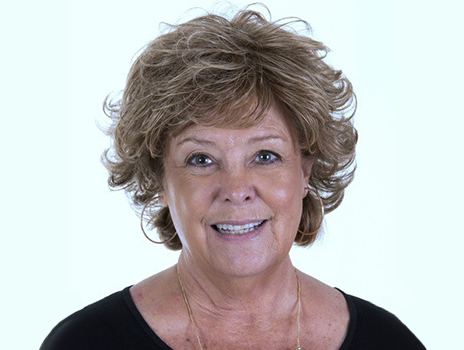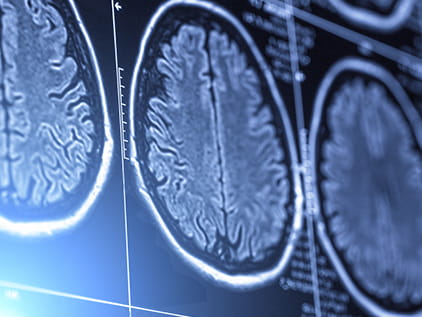Advanced Neurosurgery Restores Quality of Life


November 19, 2018
Carole Harris, 73, enjoys her family and growing trees. She has 6 children and 21 grandchildren. Feeding her passion for nature, she has planted hundreds of seeds, saplings and mature trees in or near her small hometown in northwest Missouri.
But in late May 2017, Carole's ability to do the things she loved quickly disappeared. "I started having funny little twinges near my right eye," remembers Carole. Over the next few days, the fluttering feelings grew into pains that stabbed like electrical shocks and affected the entire right side of her face.
She says, "I had shooting pain in exactly half of my tongue. Half of my nose. My right eye. It was scary."
The episodes came and went without warning. A light breeze blowing across her cheek might trigger an attack. Changing her head position while sleeping could set it off. "Every time it happened, I would jump like I had received an electric shock," she shares.
Carole visited her primary care physician, who wondered at first if she might have shingles. She also consulted with her local eye doctor, dentist and chiropractor. They were all supportive, but could not find the cause of her severe symptoms.
The primary care physician then prescribed a low dose of antiseizure medication.
"When this didn't help, I went to the hospital, where I stayed for nearly 3 weeks," Carole says. "They changed the dosage every other day until I finally went home taking 60 milligrams every 3 hours around the clock."
Carole says the drugs controlled her pain but made her life miserable. She had to take the pills every 3 hours, even throughout the night. Missing a dose was risky. Not only was the medication a hassle, it made her feel numb. "All I wanted to do was sleep," Carole explains. "I couldn't drive. I couldn't even walk a straight line. I needed two hands to pick up a glass of water."
Carole's husband, Mike, threw himself into researching her disorder online. He discovered a chronic pain disorder called trigeminal neuralgia. Carole says, "No one I knew had ever heard of it. And when I described it to people, they kind of found it hard to believe."
The trigeminal nerve starts at the brain stem and separates into 3 branches that supply feeling to different areas of the face. Neuralgia, or severe pain, of this nature often arises when a blood vessel presses on the nerve.
Mike continued his research. One day he told Carole, "I found a doctor in Kansas City and that's where we're going."
That doctor was neurosurgeon Michael Kinsman, MD, at The University of Kansas Health System in Kansas City.
Trigeminal neuralgia is sometimes called 'the suicide disease.' Patients report that on a scale of 1 to 10, their pain is a 15. It's the most severe pain imaginable. – Michael Kinsman, MD
Neurosurgeon
A week later, Carole had an appointment with Dr. Kinsman. He directed his full attention to Carole and said, "Tell me your story."
Carole knew she found the right doctor. "I couldn't believe it," she says. "Somebody was actually listening to me."
Dr. Kinsman and his team see a high volume of patients with facial pain every year. They have the knowledge and experience to diagnose and treat several types of nerve pain syndromes.
Based on Carole's description, Dr. Kinsman confirmed a diagnosis of trigeminal neuralgia. He explains, "It's sometimes called 'the suicide disease.' Patients report that on a scale of 1 to 10, their pain is a 15. It's the most severe pain imaginable."
Patients suffering from trigeminal neuralgia often undergo many procedures before they realize they need to see a neurologist or neurosurgeon. "They go to their dentists and have teeth pulled. They have sinus surgeries," says Dr. Kinsman. "They'll try anything to get rid of the pain."
Dr. Kinsman ordered a brain MRI for Carole to rule out other conditions such as a brain tumor or multiple sclerosis. The scan revealed a blood vessel compressing the trigeminal nerve.
Carole had found the months of antiseizure medications intolerable. Fortunately, Dr. Kinsman and his team had a range of other treatment options to offer Carole.
Noninvasive outpatient procedures include radiofrequency rhizotomy and radiosurgery. This involves injuring the nerve that carries the pain signal, reducing or getting rid of the pain of trigeminal neuralgia. But the gold standard of care is craniotomy with microvascular decompression, and this is what Dr. Kinsman and Carole together chose.
Dr. Kinsman used a computerized, 3D model of Carole's anatomy based on her MRI and a skull model to explain the surgery. "He showed me where the incision in my skull would be," she says. "I saw where the blood vessel and nerve were bumping together to create these awful shocks."
"The procedures aren't permanent," Dr. Kinsman informed Carole. "The goal is to punt the disease process down the road to relieve pain for as long as possible. Microvascular decompression offers the lowest risk of symptom recurrence."
Carole's husband was understandably apprehensive. But Carole didn't hesitate. After everything she had been through, she wanted this horrible condition cured. She said, "Do it."

At the forefront of academic medicine, our physicians use the industry's latest technologies to support effective neurosurgical care.
Carole's November 1 surgery was expected to last 3 to 4 hours. During surgery, Dr. Kinsman discovered Carole's blood vessel was not just pressing against the trigeminal nerve, it was completely wrapped around it. Unraveling the blood vessel required extra time and precision plus the expertise of the specialized physicians at The University of Kansas Health System.
When Carole woke from surgery, she was overjoyed to find 5 of her children in the room and the 6th on the phone. She spent just 36 hours in the hospital, and it was all positive. "Dr. Kinsman is amazing," she says. "The nurses were all so good. Everyone was incredibly nice."
We offer a variety of appointment types. Learn more or call 913-588-1227 to schedule now.
Today, the pain of trigeminal neuralgia is just a bad memory for Carole. She's caring for her grandbabies again. And she can't wait for the ground to thaw so she can get back on her tractor and dig more holes for trees.
"I thank my husband every day for finding Dr. Kinsman," raves Carole. "And I say prayers for Dr. Kinsman every day because I know he is saving people's lives. I'm his biggest fan."